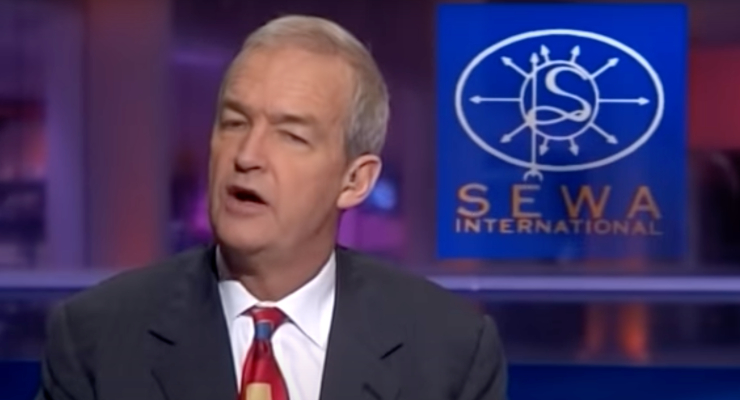
Charity case A tipster pointed out something we missed: in response to India’s horrifying experience of COVID-19, the West Australian government has been promoting donations to Sewa International since early last month. And look, obviously we’re not knocking the WA government for attempting to help a truly dire situation, and we make no specific allegations about the conduct of the WA branch. ButSewa is an interesting choice. Also the charity du jour for Google, Twitter and Microsoft, Sewa International has allegedly worked to spread Hindu nationalist ideology in India and internationally for decades. As Slate reports:
A 2002 investigation by the UK’s Channel 4 tracked money raised from British donors by Sewa International for earthquake relief and found that they went towards Hindu nationalist organisations and projects in India, without proper disclosure of how the funds were being used. These findings were bolstered in a 2004 report by the UK-based, South Asia–focused human rights group Awaaz, which detailed how internationally raised relief funds went to groups that directly incited communal violence in 2002 during the Gujarat riots, which saw months of attacks on Muslims by Hindu extremists.
An odd Joyce Yesterday was Barnaby Joyce’s second first question time as deputy prime minister, since Michael McCormack was ousted by his colleagues (though it seems a stiff breeze could have done it). Looking to capitalise on the optics of someone with unresolved sexual harassment claims over his head returning to the party’s top job, Labor’s Julie Collins asked: “In his capacity [as] minister for regional development, what does the deputy prime minister say to women in agriculture?” To which Joyce provided the auto-complete conservative bloke answer to that kind of question:
I thank the member for her question, might I say, as a father of four daughters … I have an incredible vested interest in making sure women in agriculture and every section of society have the best opportunity in the safest environment they could possibly live in.
Apart from the resort to short-sighted sexist cliché, it’s a strange way to illustrate his moral fortitude and commitment to women’s issues. After all, Joyce had four daughters back in 2018 when he was forced to resign. Hell, he had daughters back in 2006 when he opposed an effective HPV vaccine for women on the grounds it may give young women a “licence to be promiscuous”.
The Australian spruiks a carbon price Today’s Australian reports on a “strong push among ministers and backbenchers to promote nuclear energy as a greenhouse gas reduction measure and reduce Australia’s reliance on coal- and gas-fired power stations”. Certainly, according to many experts, there is a path to nuclear energy as a viable option in Australia, but we don’t think many Coalition figures are going to like it.
As we’ve long reported, there are several barriers to nuclear power in Australia, primarily that the whole thing is incredibly expensive because Australia doesn’t have any nuclear infrastructure. There is only one way, in the eyes of many credible nuclear spruikers, for nuclear energy to compete with existing energy sources: impose a carbon price.
Dr Ziggy Switkowski, who undertook a review on the viability of nuclear power for the Howard government in 2007 (before being appointed chair of the Australian Nuclear Science and Technology Organisation) is a big fan of nuclear energy.
But his 2007 review found that nuclear became viable compared with coal and gas only if there was a carbon price. Economist and Crikey contributor John Quiggin has also recently argued in favour of nuclear energy in Australia — his figures, too, rely on a carbon price.
Jabber Hutt A sad day as the Hutt River property is put up for sale. Located nearly 600km north of Perth, the Hutt River Province lasted as a micronation for 50 years after a dispute over the state’s wheat quotas between the government and the late founder Leonard Casley. It became an international tourist attraction, and even briefly declared war on Australia in 1977.
Prince Leonard died in 2019 at the age of 93 and last August a little chapter in Australia’s sovereign citizen movement came to an end when the nation formally dissolved under the weight of COVID-19 and a huge tax bill.








Modern nuclear designers set a top limit of US$100/MWh, with the various designs variously below that. However that rate is only during the period of playback, nominally 30 years. For the following 50 or 70 years the price per unit drops away to next to nothing, as nukes have very little wear and tear, and the fuel costs very little.
Dr Ziggy Switkowski did indeed propose (~2007) a carbon tax of Aus$30 per tonne for the big gigawatt plants to compete with fossil. However more recently (~2019) he urges us to look at the factory-built “small modular reactors” as a means of rapid construction, low capital cost and high compatibility with the grid. With an international commitment for mass purchases, reactors designed for serial construction in factories can then be mass produced. Economies of scale can then be expected to undercut the 30-year cost of coal or gas plants. Anyway, aren’t we investing in a carbon-free future, or are we just paying a fine for our past emissions?
There is a certain risk involved in case you had not noticed a few melt downs and. the like.!
On the contrary, 2c6_etc, a nuclear powered world offers negligible risk compared to the dreadful certainties of climate change.
Across the last 60 years, the 400-odd reactors around the world have been uneventfully boring, with few worker casualties and even fewer bystander casualties. Unlike the endless disasters from coal mines, gas explosions, hydro dams and the endless trickle of worker injuries on wind farms and solar roofs.
Even at Fukushima, the proudest victory of the antinuclear fearmongers, there were zero fatalities due to radiation. That’s not just a lower number of deaths than an equivalent fossil accident, nor a small number, not even a negligible number, it was absolutely zero. However there were hundreds killed by the antinuclear fearmongering as the induced fear Japan rose to near-panic, and more than a thousand were killed in the otherwise unnecessary evacuation that was raised to quell the panic.
It is fearmongering that is our greatest obstruction to full decarbonisation. Idle hands who might be tempted to fearmongering would be more useful raising the storm of urgency that is needed.
To Peter Wotton Would love to know the number of injuries/deaths at Solar Farms, either during construction or afterwards!? OH&S should ensure these are at an absolute minimum. not the most compelling argument in favour of Nuclear!! The real point is that in Australia, renewables have the potential in the short/medium term to obviate the need for either Coal OR Nuclear!! Yes, gas may be needed a bit longer during the transition, so why bother with nuclear at all ?? thanks….where is Roger’s response????
It would be irresponsible to suggest that wind and solar can replace fossil power by themselves. True, wind-plus-gas or solar-plus-gas could power Australia if we let gas expand that far. But it is gas itself that must be exterminated, currently by 2050. We need a noncarbon fuel to do the heavy lifting. For that, we must contemplate uranium or thorium as the replacement.
All nuclear reactors require massive volumes of water for cooling. As our rivers dry up where it that water to be found.
While there is much talk of factory-built “small modular reactors”, there is little evidence that these either exist or that they provide cheap energy
The nuclear argument is a little dented by the two latest nuclear generators in UK and France. Both Hamanville (France) and Hinkley Point C (UK) have both come on line a decade late and at double original budget. More tellingly, the electricity that they generate is far more expensive that the renewables alternative and in the case of Hinkley Point C is the most expensive in Europe.
I think you are referring to the EPR, a gigantic reactor designed to take over from coal on the similarly gigantic European grid. The first two prototypes, in at Olkiluoto in Finland and Flamanville in France, were built on a learn-as-you-go basis, and did have time and cost overruns, leaving the design still incompletely resolved. In contrast, Australia would only start small, with a proven design already in production. I believe this is why Dr Ziggy Switkowski is advising us to look at the SMRs, the “small modular reactors”. (Interested readers might like to look up “Nuscale” for a start)
After all, Joyce had four daughters back in 2018 when he was forced to resign. Hell, he had daughters back in 2006 when he opposed an effective HPV vaccine for women on the grounds it may give young women a “licence to be promiscuous”.
All of which caused me to wonder whether Vikki C had had the gardasil jab.
So a carbon price is good but only if it doesn’t make nuclear economical viable. If economic viability is your only argument against nuclear power so be it.